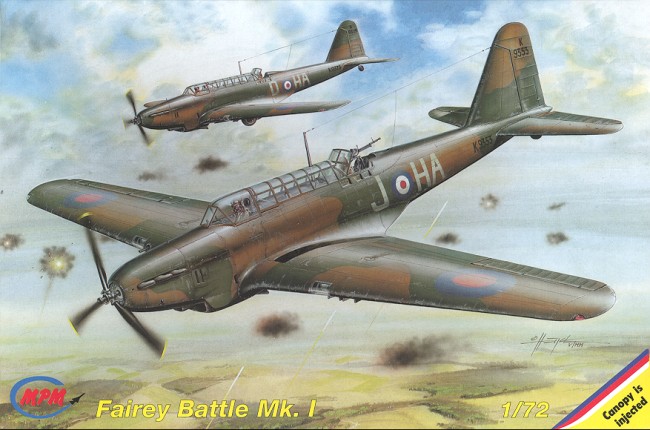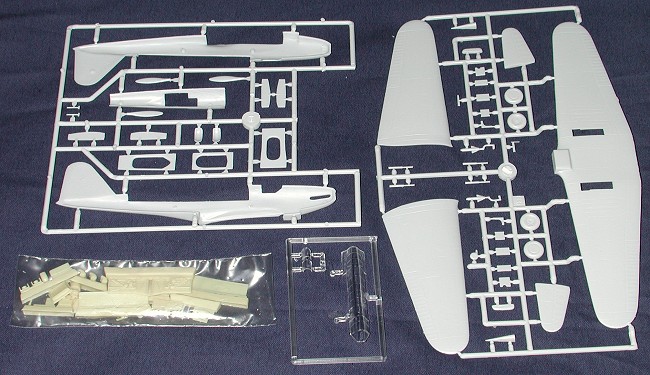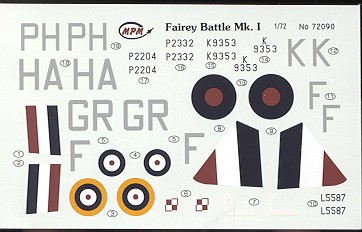
|
KIT: |
MPM 1/72 Battle I |
|
KIT # |
72090 |
|
PRICE: |
$18.98 |
|
DECALS: |
Four aircraft |
|
REVIEW & |
|
|
NOTES: |
Multimedia short run kit |

|
HISTORY |
It is interesting to look back into the history of the airplane. You can see that there are definite periods of great advancement, followed by times when things sort of stood still for a while to allow technology to be put into use. There are a number of external forces that drive development and improvement in technology. One of those, unfortunately, is war.
After the initial development of the aircraft in the early 1900's the aircraft development literally took off during WWI. Then there were the lean years of the 20s followed by a renewed impetus in the 1930s with monoplane development. WWII lead to the development of turbine engines and the huge steps in speed that followed. Since then, there have been no more really dynamic leaps in aircraft and airframe development. Composites are now more of the airframe, but that was a slow progression. So was engine and avionics development. Radial developments such as VTOL and Swing wings had their day but have fallen out of favor. I would think that the next big development will be in ground to orbit to ground vehicles or spaceplanes.
Getting back to the monoplane development of the thirties. These aircraft were seen as the best way to produce fast military aircraft. So the RAF put forth a proposal in 1933 for a fast, single engined bomber. The idea was to have this aircraft be so fast that it would be able to out perform the fighters of the time. This became the Battle bomber. And it did outperform the fighters of the early 30's. Unfortunately, fighter development also improved so that by the time the Battle entered battle, so to speak, it was woefully ill equipped to deal with the threat. Needless to say, it takes war to point out these problems and the Battle was produced in a time of no war; from the first flight in 1936 until production stopped in late 1940, nearly 2200 Battles came off the line, many of them being relegated to trainers as soon as they were built.
Experience in France in 1940 had shown that the Battle, though only 4 years old as an airplane, was not capable of operating in a hostile environment the way it was designed to do. With in the first month of the war, it was taken off daylight operations. It was only during the desperate days of May and June 1940 that the Battles of the AASF (Allied Air Strike Force) were again used in daylight raids, often with terrible consequences to Battle crews. The now famous Maastricht bridges attack, while brave and resulting in the first award of the Victoria Cross to the RAF in WWII, was also awarded posthumously.
After the fall of France, Battles were generally relegated to secondary and training duties. A large number were converted to target tugs or to gunnery training schools. Some were used for coastal patrol. The type was officially declared obsolete in 1944, four years after it was painfully obvious that it was no longer a front line aircraft. Battles were also exported to Belgium and, I believe, Greece. One is currently on display at the RAF Museum in Hendon.
|
THE KIT |

MPM has been around now for about 10 years. Hard to believe that it has been that long, but it has. The company has moved from its humble beginnings to being a real force in the modeling world. With the larger companies no longer producing kits as prodigiously as they were, we now have to rely more and more on the offerings from the Czech Republic. Why it is that this country has become such a powerhouse in the world of scale modeling is something that I find truly amazing, especially considering that it was not so long ago that they were under Soviet domination.
This kit is one of the new breed of short run kits. MPM has been listening to their buying public and has made some very welcome changes, mostly with the addition of injected clear parts instead of the vacuformed one. They have also included more resin parts and have limited or eliminated the etched metal bits that so many have trouble using. Now if we could get away from the separate propeller blades, I'd be happier!
Molded in the usual semi soft light grey plastic, this kit has all the trappings of the genre. Finely engraved panel lines, a good representation of fabric covered surfaces, smaller sprue gates to the parts, an almost total absence of flash on the injected pieces, ejector stubs only on the large parts (wings, fuselage), superbly done resin parts, a great decal sheet, and injected clear bits. The clear bits have a bit of distortion in them and mine had a couple of stress lines, but this is a learning experience for MPM as it was for Eduard and others.
 The resin parts
are for floor and sidewalls of the fore and aft cockpit as well as the seats,
sticks and instruments that go in there. A set of exhaust, intakes, landing
lights and aft machine gun are also resin. Some small tubular parts like the
canopy braces and pitot tubes will have to be made by the builder. Instructions
are more than adequate, giving eight construction steps. Each step has a color
key giving Humbrol paints. FS numbers are given for the exterior colors. There
are four decal options. The decal maker is not printed on the sheet, but it is
of very high quality with no registration problems at all. All of the aircraft
are painted in Dark Earth and Dark Green uppers with Black undersides. You are
given two aircraft from 12 Squadron and the fateful Maastricht bridges attack,
as well as one from 301 Squadron and 218 squadron. There are some differences in
the markings on these aircraft, with two of them carrying the A camo scheme and
two of the the mirrored B camo scheme.
The resin parts
are for floor and sidewalls of the fore and aft cockpit as well as the seats,
sticks and instruments that go in there. A set of exhaust, intakes, landing
lights and aft machine gun are also resin. Some small tubular parts like the
canopy braces and pitot tubes will have to be made by the builder. Instructions
are more than adequate, giving eight construction steps. Each step has a color
key giving Humbrol paints. FS numbers are given for the exterior colors. There
are four decal options. The decal maker is not printed on the sheet, but it is
of very high quality with no registration problems at all. All of the aircraft
are painted in Dark Earth and Dark Green uppers with Black undersides. You are
given two aircraft from 12 Squadron and the fateful Maastricht bridges attack,
as well as one from 301 Squadron and 218 squadron. There are some differences in
the markings on these aircraft, with two of them carrying the A camo scheme and
two of the the mirrored B camo scheme.
Overall, it looks like a very nice kit. It is light years better than the poor old Airfix kit, which was based on incorrect drawings. I'll leave it to the experts to determine if this kit is the right length, height, or wingspan. It certainly looks much more like a Battle than the Airfix kit. According to the parts breakdown sheet, there are at least two more Battle variants in the pipeline.
|
REFERENCE |
Aircraft of the Royal Air Force since 1918, by Owen Thetford, Putnam, 1979 (7th edition)
If you would like your product reviewed fairly and quickly by a site that has over 1,700 visits a day, please contact me or see other details in the Note to Contributors.
Additional notes: Sten Ekedahl is a real fan of the Battle, and posted his findings concerning problem areas of the kit on the newsgroup RMS. Here is what Sten has to say about it. "Rear of the radiator solid. No provision for the bomb aimer's clear panel under the central fuselage, just an engraved panel. Wing tips slightly too rounded at the rear quarters (easily sanded to shape). Fuselage about 5 mm too long (seems evenly distributed along the length). Nose side profile slightly too flat between the windscreen and the propeller. Canopy is terrible! The movable portion over the pilot's cockpit is about 3-4 mm too short and has a couple of extra frames that I think only was featured on the prototype. Also the top profile is absolutely flat where it should be slightly curved when looking from the side. There is no provision for an open position, neither for the pilot's cockpit nor for the rear gunner. This I am not too sure about, but I also think the canopy sides slope too much making the canopy a bit too narrow at the top. The fuselage top decking is slightly too wide at the bottom."
Though Sten went into what seems like a lot, much of his displeasure surrounds the canopy. In addition most of the dimension concerns are not that great and can be corrected. In the end, I think you will be pleased with the resulting model. It is much better than the old Airfix model and when done will look very much like a Battle, which is all that the majority of modelers are looking for.